
wireless routers
Type : Wireless
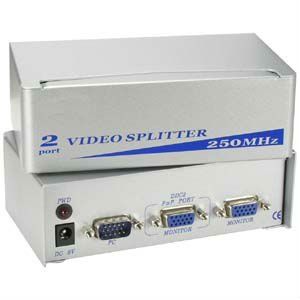
vga splitter with adapter
Products Status : Stock

Vga Splitter
ADSL SPLITTER ADSLSplitters and filters cause the most avoidable installation problems for ADSL users. A filter or splitter is essential wherever a telephone or other device shares a line with an ADSL modem. Filters and splitters eliminate the high frequency noise used by ADSL services from being heard on the phones. Splitters and filters perform the same function but in two ways. A splitter divides the signal into two parts one part containing the ADSL signal and the other containing only voice. Filters block the ADSL signal and allow the voice to go through. Splitters typically have 3 labels: ADSL, Phone and Line. To use a splitter you connect your telephone devices (eg phone, fax or answering machine) to the connection labelled phone, your ADSL modem to the ADSL connection and the line to the wall socket. If you have other telephone wall sockets in the property on the same telephone line you will need to plug in filters between the phone and the wall socket. In addition to the user installable spliter in the photograph above, you can have a central splitter installed by a telephone technician. Acentral splitter is installed on the telephone line before the first phone point in the property. Thus the central splitter protects the all the phone exensions from the ADSL signal. A new phone point is wired into the central ADSL splitter specifically for the ADSL modem. The ADSL modem will not work on any other point in the property. Central Splitters are sometimes used when user installable splitters and filters do not result in a reliable ADSL connection. VGA SPLITTER VGA splitter is the perfect device if you need to display the same images to different monitors. It allows you to display the same image on many monitors and cascade relaying of signals at local as well as distant locations simultaneously. It is offered n 2, 4, 8 and 16 ports and the same image can be displayed on upto 16 monitors using this splitter. For amplified VGA outputs, the cascading function can be utilized. These splitters are compatible with VGA, SVGA and multi sync monitors. It has an impressive bandwidth of 350 MHz and the output is crystal clear images without any signal degradation or breakage. Moreover it also makes the work area clutter free since the computer can now be located in a safe location. It improves the work environment by making it noise free as well.The commonly used splitter in this particular category is the VGA Splitter. The installation is relatively simple and easy. It works on easy plug and play functionality and can be done in seconds. The splitter is connected via a VGA cable from the computer's graphic port to the splitter input. Out of the many outputs, the focal connection is used for the main display while the rest are connected to other display devices. They come with a built in booster circuit which allows the VGA monitors to be positioned at greater distances from the source. It can be kept on a desktop while the 16 port unit can be rack mounted.A VGA Splitter Display the Same Images to Different Monitors: It is the perfect device to transmit video information on several monitors and monitoring work environments from secure locations. It has an impressive bandwidth and the output is high resolution clear images. Thus it is commonly used in trade shows, presentations, showroom display, hotels, digital signage applications etc.
...more
VGA Cable
Specifications All types of wires, cables, connectors, cable assemblies, power cords, extension cords, HDMI switches, cable clips are available A Video Graphics Array (VGA) connector is a three-row 15-pin DE-15 connector. The 15-pin VGA connector is found on many video cards, computer monitors, and some high definition television sets. On laptop computers or other small devices, a mini-VGA port is sometimes used in place of the full-sized VGA connector. DE-15 is also conventionally called RGB connector, D-sub 15, mini sub D15, mini D15, DB-15, HDB-15, HD-15 or HD15 (High Density, to distinguish it from the older and less flexible DE-9 connector used on some older VGA cards, which has the same shell size but only two rows of pins). VGA connectors and cables carry analog component RGBHV (red, green, blue, horizontal sync, vertical sync) video signals, and VESA Display Data Channel (VESA DDC) data. In the original version of DE-15 pinout, one pin was keyed and 4 pins carried Monitor ID bits which were rarely used; VESA DDC redefined some of these pins and replaced the key pin with +5 V DC power supply. The VGA interface is not engineered to be hotpluggable (so that the user can connect or disconnect the output device while the host is running), although in practice this can be done and usually does not cause damage to the hardware or other problems. However, nothing in the design ensures that the ground pins make a connection first and break last, so hotplugging may introduce surges in signal lines which may or may not be adequately protected against. Also, depending on the hardware and software, detecting a monitor being connected might not work properly in all cases. Cable quality The same VGA cable can be used with a variety of supported VGA resolutions, ranging from 640×400px @70 Hz (24 MHz of signal bandwidth) to 1280×1024px (SXGA) @85 Hz (160 MHz) and up to 2048×1536px (QXGA) @85 Hz (388 MHz). There are no standards defining the quality required for each resolution, but higher-quality cables typically contain coaxial wiring and insulation which make them thicker. A quality cable should not suffer from signal crosstalk which occurs when the signals in one wire induce unwanted currents in adjacent wires, ghosting which occurs when impedance mismatches cause signals to be reflected (note that ghosting with long cables may not be the fault of the cable but may instead be caused by equipment with incorrect termination or by use of passive splitters), and other signal degradation effects; shorter VGA cables are less likely to introduce significant degradation. Some higher-end monitors and video cards featured 5 separate BNC connectors for RGBHV signal, allowing highest quality connection using five 75 ohm coaxial cables. Adapters There are HDMI to VGA and DVI to VGA adapters, and VGA to SCART converters. For a simple VGA to SCART adapter cable to be viable, the display card must have sufficient features. Namely the ability to provide interlaced output and adjust the frequency, number of total scan lines and number of visible lines (the actual resolution) to match those of the prevailing TV standard. Signal incompatibility rises from the fact that SCART uses composite sync, so either display card must be able to do so too, or sync signals must be summed with a simple circuit. Additionally some TV sets may require 1 volt voltage on SCART pin 16 as explicit signal to use component instead of composite signal. Likewise, three conductor analog RGB signal uses composite sync on green, but a converter circuit for to achieve that is simple as well. 1. HDMI/DVI to VGA adapters do not carry the audio channel. Separate audio cables are used. 2. HDMI to VGA adapters generally won't be useful as most displays can't read analog over the HDMI port.
...more
usb lights
Application : Laptop
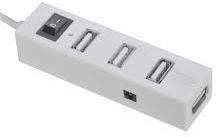
Usb Hub
Ports : 2-4
Interface Type : USB 2.0
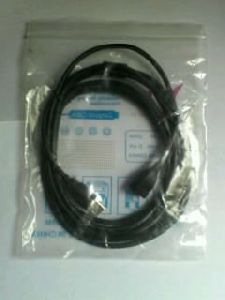
USB Extension Cable
All types of wires, cables, usb extension cables, power cords, extension cords, HDMI switches, cable clips are available In today's technology-centered world, it is necessary to be able to connect your consumer electronics, such as keyboards, speakers, printers and more, to your computer. You can attach these devices to your PC using universal serial bus (USB) interface technology. USB cables establish communication between technological devices and allow you to transfer information as fast as 480Mbps (mega bits per second). USB cables rely on ports and connectors to establish a connection between your PC and USB-enabled devices. The connectors on both ends of the flexible cable include contacts, which slide in easily to the receptors located on the computer and on the source device. This simple technology improves communication between devices and is essential to maximizing the use of your PC. USB cables provide quick device communication and information transfer up to 5 meters without delay. USB extension cables can establish additional device connection over 5 meters. USB Cables: What to Look For Not all USB cables are created equal. Multiple shapes and sizes of connectors outfit USB cables, so you must purchase the correct cable to connect your devices. Cables can be made with Type A or Type B connectors in mini, micro or standard size, and the connectors can be male or female. USB cables also come in many different lengths, so it's best to have a general idea of the distance between your devices so you can buy the right length of cable. The best cable companies also provide great help and support and supply a cable warranty. FeaturesUSB 2.0 cables are the second generation of USB technology and are the most widely used. Double shielding technology protects these high-speed data transfer cables and blocks out interfering signals from other devices. These cables also come with different connectors. Because many consumer electronic devices include a port for a Type A connection, and most PCs include USB ports that need a Type B connection, it makes sense that the most commonly used cables consist of a Type A connector on one end and a Type B connector on the other. This standard type of USB cable will connect most devices to your PC. Length Options The universally supported 2.0 version of the USB cable functions optimally at or under a length of 5 meters, or around 16 feet. These cords are available in lengths of 3 feet, 6 feet, 10 feet, 15 feet and 16 feet. Depending on what you are connecting, it is best to purchase the shortest available cable to ensure fast and easy data transfer and to reduce the possibility of interference. A USB extension cable provides additional connection between devices that are separated by over 16 feet. Help & SupportNot all connections are perfectly smooth, and not all USB cables are flawless. It is essential for USB cable companies to provide a warranty and a method of communication in case you need to return a product. Some manufacturers also provide live chat assistance, which we have found to be a very useful tool.
...more
USB Card Reader
Various usb products are available, some are usb fan, usb sharer 2 ports, usb sharer 4 ports, usb to IDE/SATA with Adapter etc. LAN CARD With the increasing use of the computers and the networking the local area network of the LAN is one such network type which links the two computers in a connection. For this connection a Local area network card or the LAN card is required which enables the connection of the computers in a network. It is a piece of hardware which is connected inside the PC linking the computer network. The LAN Card is of both the common types which are the OSI layer 1 and 2, dealing with the physical as well as the data link layer respectively. It uses the correctly entered MAC addresses for the network to work. This then allows the computers to connect using cables or even wirelessly which then requires a special type of LAN card called the WLAN card. With the increase in the development and technology, the local area network of the wireless type is now mostly preferred. Therefore a Wireless LAN Card is required for this purpose. The computers with the wireless LAN Card can transmit and receive data via radio waves using the special technology of SST or the Spread-Spectrum technology. The wireless LANs are available in four basic types which include the 802.11, followed by type a, b and also g.
...more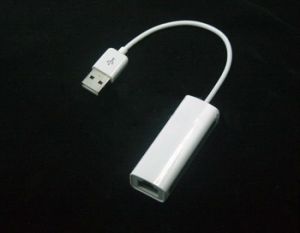
usb bluetooth
Specifications Various usb products are available, some are usb fan, usb sharer 2 ports, usb sharer 4 ports, usb to IDE/SATA with Adapter etc. LAN CARD With the increasing use of the computers and the networking the local area network of the LAN is one such network type which links the two computers in a connection. For this connection a Local area network card or the LAN card is required which enables the connection of the computers in a network. It is a piece of hardware which is connected inside the PC linking the computer network. The LAN Card is of both the common types which are the OSI layer 1 and 2, dealing with the physical as well as the data link layer respectively. It uses the correctly entered MAC addresses for the network to work. This then allows the computers to connect using cables or even wirelessly which then requires a special type of LAN card called the WLAN card. With the increase in the development and technology, the local area network of the wireless type is now mostly preferred. Therefore a Wireless LAN Card is required for this purpose. The computers with the wireless LAN Card can transmit and receive data via radio waves using the special technology of SST or the Spread-Spectrum technology. The wireless LANs are available in four basic types which include the 802.11, followed by type a, b and also g. Any sort of LAN card you use will have some of the typical features of a network card which includes the twisted pair, the AUI socket and also the BNC. It is at the AUI socket that the network cable has to be connected. The LAN cards usually are designed to support the rate transfer to be ranging from 10 to 1000 megabits per second. USB BLUETOOTH A personal computer that does not have embedded Bluetooth can be used with a Bluetooth adapter that will enable the PC to communicate with other Bluetooth devices (such as mobile phones, mice and keyboards). While some desktop computers and most recent laptops come with a built-in Bluetooth radio, others will require an external one in the form of a dongle. Unlike its predecessor, IrDA, which requires a separate adapter for each device, Bluetooth allows multiple devices to communicate with a computer over a single adapter. Bluetooth exists in many products, such as the iPod Touch, Lego Mindstorms NXT, PlayStation 3, PSP Go, telephones, the Nintendo Wii, and some high definition headsets, modems, and watches. The technology is useful when transferring information between two or more devices that are near each other in low-bandwidth situations. Bluetooth is commonly used to transfer sound data with telephones (i.e., with a Bluetooth headset) or byte data with hand-held computers (transferring files). Bluetooth protocols simplify the discovery and setup of services between devices. Bluetooth devices can advertise all of the services they provide. This makes using services easier because more of the security, network address and permission configuration can be automated than with many other network types.SOUND CARD A sound card (also known as an audio card) is an internal computer expansion card that facilitates the input and output of audio signals to and from a computer under control of computer programs. The term sound card is also applied to external audio interfaces that use software to generate sound, as opposed to using hardware inside the PC. Typical uses of sound cards include providing the audio component for multimedia applications such as music composition, editing video or audio, presentation, education and entertainment (games) and video projection. Sound functionality can also be integrated onto the motherboard, using basically the same components as a plug-in card. The best plug-in cards, which use better and more expensive components, can achieve higher quality than integrated sound. The integrated sound system is often still referred to as a "sound card".
...more
USB
Specifications 2gb, 4gb, 8gb, 16gb , 32gb usb/pendrives are available with 3 year warranty. Call for quotation. Flash memory combines a number of older technologies, with lower cost, lower power consumption and small size made possible by advances in microprocessor technology. The memory storage was based on earlier EPROM and EEPROM technologies. These had very limited capacity, were very slow for both reading and writing, required complex high-voltage drive circuitry, and could only be re-written after erasing the entire contents of the chip. Hardware designers later developed EEPROMs with the erasure region broken up into smaller "fields" that could be erased individually without affecting the others. Altering the contents of a particular memory location involved copying the entire field into an off-chip buffer memory, erasing the field, modifying the data as required in the buffer, and re-writing it into the same field. This required considerable computer support, and PC-based EEPROM flash memory systems often carried their own dedicated microprocessor system. Flash drives are more or less a miniaturized version of this. The development of high-speed serial data interfaces such as USB made semiconductor memory systems with serially accessed storage viable, and the simultaneous development of small, high-speed, low-power microprocessor systems allowed this to be incorporated into extremely compact systems. Serial access requires far fewer electrical connections for the memory chips than does parallel access, which has simplified the manufacture of multi-gigabyte drives. A USB flash drive is a data storage device that includes flash memory with an integrated Universal Serial Bus (USB) interface. USB flash drives are typically removable and rewritable, and physically much smaller than a floppy disk. Most weigh less than 30 g. As of September 2011 drives of 256 gigabytes (GB) are available, Storage capacities as large as 2 terabytes are planned, with steady improvements in size and price per capacity expected. Some allow up to 100,000 write/erase cycles, depending on the exact type of memory chip used, and a 10 year shelf storage time.USB flash drives are often used for the same purposes for which floppy disks or CD-ROMs were used. They are smaller, faster, have thousands of times more capacity, and are more durable and reliable because they have no moving parts. Until approximately 2005, most desktop and laptop computers were supplied with floppy disk drives, but floppy disk drives have been abandoned in favor of USB ports. USB flash drives use the USB mass storage standard, supported natively by modern operating systems such as Linux, Mac OS X, Windows, and other Unix-like systems, as well as many BIOS boot ROMs. USB drives with USB 2.0 support can store more data and transfer faster than much larger optical disc drives like CD-RW or DVD-RW drives and can be read by many other systems such as the Xbox 360, PlayStation 3, DVD players and in some upcoming mobile smartphones. Nothing moves mechanically in a flash drive; the term drive persists because computers read and write flash drive data using the same system commands as for a mechanical disk drive, with the storage appearing to the computer operating system and user interface as just another drive. Flash drives are very robust mechanically. A flash drive consists of a small printed circuit board carrying the circuit elements and a USB connector, insulated electrically and protected inside a plastic, metal, or rubberized case which can be carried in a pocket or on a key chain, for example. The USB connector may be protected by a removable cap or by retracting into the body of the drive, although it is not likely to be damaged if unprotected. Most flash drives use a standard type-A USB connection allowing plugging into a port on a personal computer, but drives for other interfaces also exist. USB flash drives draw power from the computer via the USB connection. Some devices combine the functionality of a digital audio player with USB flash storage; they require a battery only when used to play music.
...more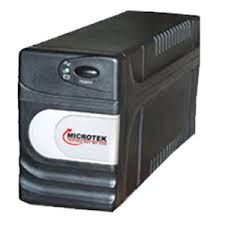
Ups
Brands like Intex, Luminous, Cyber Power, Microtek, APC, Numeric etc are available at very attractive prices. An uninterruptible power supply, also uninterruptible power source, UPS or battery/flywheel backup, is an electrical apparatus that provides emergency power to a load when the input power source, typically mains power, fails. A UPS differs from an auxiliary or emergency power system or standby generator in that it will provide near-instantaneous protection from input power interruptions, by supplying energy stored in batteries or a flywheel. The on-battery runtime of most uninterruptible power sources is relatively short (only a few minutes) but sufficient to start a standby power source or properly shut down the protected equipment. A UPS is typically used to protect computers, data centers, telecommunication equipment or other electrical equipment where an unexpected power disruption could cause injuries, fatalities, serious business disruption or data loss. UPS units range in size from units designed to protect a single computer without a video monitor (around 200 VA rating) to large units powering entire data centers or buildings. The primary role of any UPS is to provide short-term power when the input power source fails. However, most UPS units are also capable in varying degrees of correcting common utility power problems: Voltage spike or sustained Overvoltage momentary or sustained reduction in input voltage. Noise, defined as a high frequency transient or oscillation, usually injected into the line by nearby equipment. Instability of the mains frequency. Harmonic distortion: defined as a departure from the ideal sinusoidal waveform expected on the line.
...more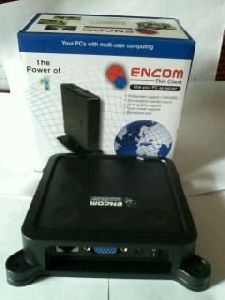
Thinclient usb
ADSL Splitter VGA Splitter 2 port with Adapter VGA Splitter 4 port with Adapter VGA Splitter 4 port with USB Power etc.. THINCLIENT A thin client (sometimes also called a lean or slim client) is a computer or a computer program which depends heavily on some other computer (its server) to fulfill its traditional computational roles. This stands in contrast to the traditional fat client, a computer designed to take on these roles by itself. The exact roles assumed by the server may vary, from providing data persistence (for example, for diskless nodes) to actual information processing on the client's behalf.
...more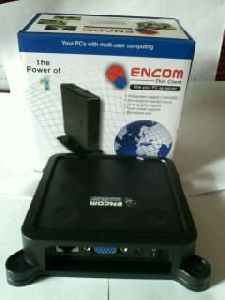
Thin client usb device
THINCLIENT A thin client (sometimes also called a lean or slim client) is a computer or a computer program which depends heavily on some other computer (its server) to fulfill its traditional computational roles. This stands in contrast to the traditional fat client, a computer designed to take on these roles by itself. The exact roles assumed by the server may vary, from providing data persistence (for example, for diskless nodes) to actual information processing on the client's behalf. Thin clients occur as components of a broader computer infrastructure, where many clients share their computations with the same server. As such, thin client infrastructures can be viewed as the providing of some computing service via several user-interfaces. This is desirable in contexts where individual fat clients have much more functionality or power than the infrastructure either requires or uses. This can be contrasted, for example, with grid computing. Thin-client computing is also a way of easily maintaining computational services at a reduced total cost of ownership.[1] The most common type of modern thin client is a low-end computer terminal which concentrates solely on providing a graphical user interface to the end-user. The remaining functionality, in particular the operating system, is provided by the server. ADSL SPLITTER ADSLSplitters and filters cause the most avoidable installation problems for ADSL users. A filter or splitter is essential wherever a telephone or other device shares a line with an ADSL modem. Filters and splitters eliminate the high frequency noise used by ADSL services from being heard on the phones. Splitters and filters perform the same function but in two ways. A splitter divides the signal into two parts one part containing the ADSL signal and the other containing only voice. Filters block the ADSL signal and allow the voice to go through. Splitters typically have 3 labels: ADSL, Phone and Line. To use a splitter you connect your telephone devices (eg phone, fax or answering machine) to the connection labelled phone, your ADSL modem to the ADSL connection and the line to the wall socket. If you have other telephone wall sockets in the property on the same telephone line you will need to plug in filters between the phone and the wall socket. In addition to the user installable spliter in the photograph above, you can have a central splitter installed by a telephone technician. Acentral splitter is installed on the telephone line before the first phone point in the property. Thus the central splitter protects the all the phone exensions from the ADSL signal. A new phone point is wired into the central ADSL splitter specifically for the ADSL modem. The ADSL modem will not work on any other point in the property. Central Splitters are sometimes used when user installable splitters and filters do not result in a reliable ADSL connection. VGA SPLITTER VGA splitter is the perfect device if you need to display the same images to different monitors. It allows you to display the same image on many monitors and cascade relaying of signals at local as well as distant locations simultaneously. It is offered n 2, 4, 8 and 16 ports and the same image can be displayed on upto 16 monitors using this splitter. For amplified VGA outputs, the cascading function can be utilized. These splitters are compatible with VGA, SVGA and multi sync monitors. It has an impressive bandwidth of 350 MHz and the output is crystal clear images without any signal degradation or breakage. Moreover it also makes the work area clutter free since the computer can now be located in a safe location. It improves the work environment by making it noise free as well.The commonly used splitter in this particular category is the VGA Splitter. The installation is relatively simple and easy. It works on easy plug and play functionality and can be done in seconds. The splitter is connected via a VGA cable from the computer's graphic port to the splitter input. Out of the many outputs, the focal connection is used for the main display while the rest are connected to other display devices. They come with a built in booster circuit which allows the VGA monitors to be positioned at greater distances from the source. It can be kept on a desktop while the 16 port unit can be rack mounted.
...more
tablet cover
Material : Leather
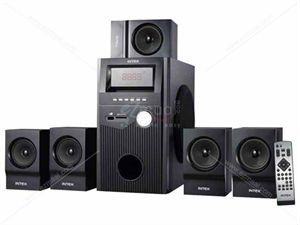
Speakers
Desktop & Laptop speakers are available:- 4050/4550/4800/5200/5600 Multimedia Speaker USB Speaker (Mini/TS-128/BF-2/F&T-2025 Computer speakers, or multimedia speakers, are speakers external to a computer, that disable the lower fidelity built-in speaker. They often have a low-power internal amplifier. The standard audio connection is a 3.5 mm (approximately 1/8 inch) stereo jack plug often color-coded lime green (following the PC 99 standard) for computer sound cards. A plug and socket for a two-wire (signal and ground) coaxial cable is widely used to connect analog audio and video components. Rows of RCA sockets are found on the backs of stereo amplifier and numerous A/V products. The prong is 1/8" thick by 5/16" long. A few use an RCA connector for input. There are also USB speakers which are powered from the 5 volts at 500 milliamps provided by the USB port, allowing about 2.5 watts of output power.
...more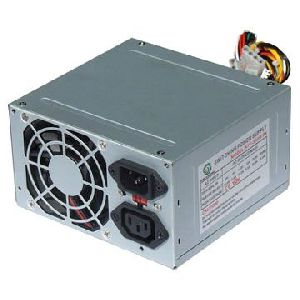
SMPS
Power supply like SMPS, UPS are available at attractive prices. Brands like Intex, Zebronics are available. A power supply is a device that supplies electric power to one or more electric loads. The term is most commonly applied to devices that convert one form of electrical energy to another, though it may also refer to devices that convert another form of energy (mechanical, chemical, solar) to electrical energy. A regulated power supply is one that controls the output voltage or current to a specific value; the controlled value is held nearly constant despite variations in either load current or the voltage supplied by the power supply's energy source. Every power supply must obtain the energy it supplies to its load, as well as any energy it consumes while performing that task, from an energy source. Depending on its design, a power supply may obtain energy from: Electrical energy transmission systems. Common examples of this include power supplies that convert AC line voltage to DC voltage. Energy storage devices such as batteries and fuel cells. Electromechanical systems such as generators and alternators. Solar power.
...more
screw driver toolkit
SCREW DRIVER TOOLKIT JACKLY 6032 / JACKLY 6036 SCREW DRIVER TOOLKIT 11 BIT SCREW DRIVER TOOLKIT BOX MAGNETIC Product list is provided below:- SCREW DRIVER TOOLKIT JACKLY 6032 SCREW DRIVER TOOLKIT JACKLY 6036 SCREW DRIVER TOOLKIT 11 BIT SCREW DRIVER TOOLKIT BOX MAGNETIC PUNCH DOWN/IMPACT TOOL CRIMPING TOOL TRIPLE LAN TESTER MOTHERBOARD TESTING CARD 2 DIGIT (DESKTOP) MOTHERBOARD TESTING CARD 4 DIGIT (LAPTOP) INTERNATIONAL ADAPTER SMPS TESTER
...more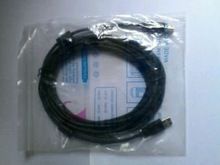
printer cable
Specifications All types of wires, cables, usb extension cables, power cords, extension cords, HDMI switches, cable clips are available Printer cable refers to the cable that carries data between a computer and a printer. There are many different types of cables, for example: Serial: RS-232, EIA-422 Parallel FireWire USB Parallel port printers have been slowly phased out, and are now difficult to find for the most part, being considered as an obsolete legacy port on most new computers. Those who have printers and scanners with only parallel port may still be able to connect the devices via the use of USB adapters a.k.a. Parallel-to-USB cable. Generally, FireWire's very high speeds of up to 800 Mbit/s are excessive for printers. USB 2.0 cable connects PCs or laptops to USB peripherals such as printers and scanners. The A-male to B-male connectors ensure a great signal transfer.
...more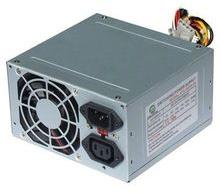
Power Supply
Specifications Power supply like SMPS, UPS are available at attractive prices. Brands like Intex, Zebronics are available. A power supply is a device that supplies electric power to one or more electric loads. The term is most commonly applied to devices that convert one form of electrical energy to another, though it may also refer to devices that convert another form of energy (mechanical, chemical, solar) to electrical energy. A regulated power supply is one that controls the output voltage or current to a specific value; the controlled value is held nearly constant despite variations in either load current or the voltage supplied by the power supply's energy source. Every power supply must obtain the energy it supplies to its load, as well as any energy it consumes while performing that task, from an energy source. Depending on its design, a power supply may obtain energy from: Electrical energy transmission systems. Common examples of this include power supplies that convert AC line voltage to DC voltage. Energy storage devices such as batteries and fuel cells. Electromechanical systems such as generators and alternators. Solar power. A power supply may be implemented as a discrete, stand-alone device or as an integral device that is hardwired to its load. Examples of the latter case include the low voltage DC power supplies that are part of desktop computers and consumer electronics devices. Commonly specified power supply attributes include: The amount of voltage and current it can supply to its load. How stable its output voltage or current is under varying line and load conditions. How long it can supply energy without refueling or recharging (applies to power supplies that employ portable energy sources).In a switched-mode power supply (SMPS), the AC mains input is directly rectified and then filtered to obtain a DC voltage. The resulting DC voltage is then switched on and off at a high frequency by electronic switching circuitry, thus producing an AC current that will pass through a high-frequency transformer or inductor. Switching occurs at a very high frequency (typically 10 kHz — 1 MHz), thereby enabling the use of transformers and filter capacitors that are much smaller, lighter, and less expensive than those found in linear power supplies operating at mains frequency. After the inductor or transformer secondary, the high frequency AC is rectified and filtered to produce the DC output voltage. If the SMPS uses an adequately insulated high-frequency transformer, the output will be electrically isolated from the mains; this feature is often essential for safety. Switched-mode power supplies are always regulated. To keep the output voltage constant, the power supply employs a feedback controller that monitors current drawn by the load. The switching duty cycle increases as power output requirements increase. SMPSs often include safety features such as current limiting or a crowbar circuit to help protect the device and the user from harm. In the event that an abnormal high-current power draw is detected, the switched-mode supply can assume this is a direct short and will shut itself down before damage is done. PC power supplies often provide a power good signal to the motherboard; the absence of this signal prevents operation when abnormal supply voltages are present. SMPSs have an absolute limit on their minimum current output. They are only able to output above a certain power level and cannot function below that point. In a no-load condition the frequency of the power slicing circuit increases to great speed, causing the isolated transformer to act as a Tesla coil, causing damage due to the resulting very high voltage power spikes. Switched-mode supplies with protection circuits may briefly turn on but then shut down when no load has been detected. A very small low-power dummy load such as a ceramic power resistor or 10-watt light bulb can be attached to the supply to allow it to run with no primary load attached. Power factor has become an issue of concern for computer manufacturers. Switched mode power supplies have traditionally been a source of power line harmonics and have a very poor power factor. The rectifier input stage distorts the waveshape of current drawn from the supply; this can produce adverse effects on other loads. The distorted current causes extra heating in the wires and distibution equipment. Switched mode power supplies in a building can result in poor power quality for other utility customers. Customers may face higher electric bills for a low power factor load. Some switch-mode power supplies use filters or additional switching stages in the incoming rectifier circuit to improve the waveform of the current taken from the AC line. This adds to the circuit complexity. Many computer power supplies built in the last few years now include power factor correction built right into the switched-mode supply, and may advertise the fact that they offer 1.0 power factor.
...more
power cable desktop
Specifications We provide all types of cables & connectors used in computer, laptops, printers, cctv camera's. Eg. VGA cable, HDMI cable etc. Computers are all about connectivity and are loaded with cables--both internally and externally--that allow data to be exchanged between the computer's components and peripherals. Power Cable Desktop computers typically use a universal power cord for power, while laptops use power adapters, often made to the specifications of the manufacture. VGA and DVI VGA and DVI cables use a series of pins to transfer video signals between devices, such as a monitor and the computer. VGA is analog, and DVI is digital. IDE and SATA IDE and SATA cables transfer data between the computer's internal components and the motherboard. The cables are pretty much the same as far as speed is concerned. USB and FireWire USB and FireWire cables allow peripherals to connect to your computer and transfer data at high speeds. FireWire cables can send and receive data at the same time, while USB cables cannot. Ethernet Ethernet cables are used to join two network devices. The cable contains four thin wires that allow data to be transferred at high speeds between the devices in the form of a series of electrical pulses.
...more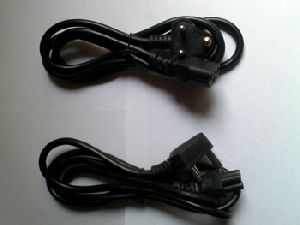
Power Cable
Specifications We provide all types of cables & connectors used in computer, laptops, printers, cctv camera's. Eg. VGA cable, HDMI cable etc. Laptop Power cables are used in laptop adapters. All types of power cables are available:- 1. medium quality 2. Heavy quality
...more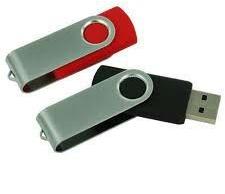
Pen Drive
Flash memory combines a number of older technologies, with lower cost, lower power consumption and small size made possible by advances in microprocessor technology. The memory storage was based on earlier EPROM and EEPROM technologies. These had very limited capacity, were very slow for both reading and writing, required complex high-voltage drive circuitry, and could only be re-written after erasing the entire contents of the chip. Hardware designers later developed EEPROMs with the erasure region broken up into smaller "fields" that could be erased individually without affecting the others. Altering the contents of a particular memory location involved copying the entire field into an off-chip buffer memory, erasing the field, modifying the data as required in the buffer, and re-writing it into the same field. This required considerable computer support, and PC-based EEPROM flash memory systems often carried their own dedicated microprocessor system. Flash drives are more or less a miniaturized version of this. The development of high-speed serial data interfaces such as USB made semiconductor memory systems with serially accessed storage viable, and the simultaneous development of small, high-speed, low-power microprocessor systems allowed this to be incorporated into extremely compact systems. Serial access requires far fewer electrical connections for the memory chips than does parallel access, which has simplified the manufacture of multi-gigabyte drives. A USB flash drive is a data storage device that includes flash memory with an integrated Universal Serial Bus (USB) interface. USB flash drives are typically removable and rewritable, and physically much smaller than a floppy disk. Most weigh less than 30 g. As of September 2011 drives of 256 gigabytes (GB) are available, Storage capacities as large as 2 terabytes are planned, with steady improvements in size and price per capacity expected. Some allow up to 100,000 write/erase cycles, depending on the exact type of memory chip used, and a 10 year shelf storage time. USB flash drives are often used for the same purposes for which floppy disks or CD-ROMs were used. They are smaller, faster, have thousands of times more capacity, and are more durable and reliable because they have no moving parts. Until approximately 2005, most desktop and laptop computers were supplied with floppy disk drives, but floppy disk drives have been abandoned in favor of USB ports. USB flash drives use the USB mass storage standard, supported natively by modern operating systems such as Linux, Mac OS X, Windows, and other Unix-like systems, as well as many BIOS boot ROMs. USB drives with USB 2.0 support can store more data and transfer faster than much larger optical disc drives like CD-RW or DVD-RW drives and can be read by many other systems such as the Xbox 360, PlayStation 3, DVD players and in some upcoming mobile smartphones. Nothing moves mechanically in a flash drive; the term drive persists because computers read and write flash drive data using the same system commands as for a mechanical disk drive, with the storage appearing to the computer operating system and user interface as just another drive. Flash drives are very robust mechanically. A flash drive consists of a small printed circuit board carrying the circuit elements and a USB connector, insulated electrically and protected inside a plastic, metal, or rubberized case which can be carried in a pocket or on a key chain, for example. The USB connector may be protected by a removable cap or by retracting into the body of the drive, although it is not likely to be damaged if unprotected. Most flash drives use a standard type-A USB connection allowing plugging into a port on a personal computer, but drives for other interfaces also exist. USB flash drives draw power from the computer via the USB connection. Some devices combine the functionality of a digital audio player with USB flash storage; they require a battery only when used to play music.
...more
pci sound card
Specifications PCI add on cards are available with different warranties at attractive prices. PCI Express Cards are also available. Sound Cards: What to Look For There isn't a whole lot to sound cards as far as key aspects. There are a few things in the mix, though, that do make a difference. For the sake of comparison, so that you can find the sound card that works for you and fits your budget, we've broken down our analysis into the following five categories. Audio PerformanceOne of the most important things to look for is the overall performance of the card. The most common measurements of performance are typically SNR (signal-to-noise ratio), frequency response and THD (total harmonic distortion). These three things are used to measure the quality of audio. Although they are not perfectly accurate, they do give you an idea of the potential performance of any audio device. Sample Rate and ResolutionSample rates refer to the speed at which the card can reduce a continuous signal to a discrete signal. The latest trend is 192 kHz, which some people might think is overkill. The reason for that is because the human ear can only hear a range from 20 Hz to 20 kHz. However, the higher sampling rates do help with ADCs (analog-to-digital conversions) and DACs (digital-to-analog conversions). Resolution is important because the larger bit depths decrease total harmonic distortion (background noise) and increase dynamic range, which gives you a better signal-to-noise ratio. I/O PortsSome input and output ports aren't as capable as others. The ports with the highest quality sound will typically be S/PDIF. Both coaxial and optical can produce some of the highest signal-to-noise ratios and resolutions while keeping distortion low. They also allow you to hook your computer to your home theater system. The 3.5mm audio port is what most non-audiophiles use on their computers. FeaturesThis section looks at whether the card connects through PCI or PCIe and also considers the processor used to power the sound card. The rest is more software attributes that are included to enhance and simplify your audio adjusting. These additions help you achieve the best performance from your sound card and make it possible to connect your sound card to A/V receivers and audio player software on your computer. API Compliant StandardsAPIs, or application programming interfaces, allow the card to interact with other software, working alongside the intermediary programs under the Features category. Some, including EAX and OpenAL, unlock greater 3D sound for gaming, giving you an edge over your opponents. The more API support, the more compatible the card is with various programs, software and hardware. All of these things together make up the most vital aspects of sound cards. No one card has everything, but the differences make it possible for you to find the card that works best for your needs. If you're a sound enthusiast and want to enhance your computer's sound capabilities, then you're on the right track.
...more
pci serial card
Type : Internal
Be first to Rate
Rate ThisOpening Hours